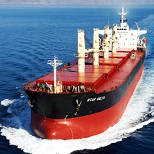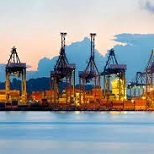Port Development Reform in Ukraine
Ukraine has got unique geographical location. If you look at the map, you will see it as heart of Europe. Thus, it is oriented towards EU and Russia. On the one hand, Ukraine has land borders with EU member countries: Poland, Hungary, Slovakia, Romania. On the other, land borders with developing Eastern European economies: Russia, Belarus, Moldova.
Port reform
In the manual you will find that investors into port activities are rather found among professional operators, cargo owners or shipping lines.
In 18 Ukrainian sea ports at the moment it is hardly possible to find a world known port operator. Only container operators may be treated as such – СTI in Ilyichevsk, HPC Ukraine in Odessa and TIS in Yuzhny.
As for cargoowners the picture is better. Ukraine is a leading exporter of commodities. So, international traders and local financial-industrial groups have already constructed a number of dedicated terminals in Ukrainian ports. Among shipping lines only CMA СGM invested into a container terminal.
What is the reason for so lazy investment? The answer is simple – it is a post-socialist regime of attracting investors. Too many public authorities are involved in the transaction. Plus unclear bidder requirements. Authorities can continuously demand additional documentation, causing significant delays and transaction costs. Sometimes, even after final negotiations, authorities can still alter the contents of the agreements, causing uncertainty and delays and changing contractual arrangements.
So, such unworkable transaction process made institutional framework weak. Main contract types were not recognized abroad and were not up to International Standards. But all the above should pass away soon, as in June 2013 the long-awaited Law on Sea Ports is coming into force. The milestones of the law are:
· Split of administrative and commercial functions in sea ports;
· promotion of investment into port infrastructure;
· liberalization of rates on port services.
From now on, port administrations will be entitled to perform administrative functions only, while commercial services will be delegated to private companies. Cargo terminals will thus become more independent and more competition is expected.
The main reform tools are privatization and concession. Land in ports may be held in any form of ownership permitted by the laws of Ukraine. So, it may be state owned or privately owned (!) which can be treated as a revolutionary move. This creates opportunities for financing the construction of new cargo terminals and ensuring a return on investments.
Inland navigation
In Ukraine the infrastructure of cargo and passenger terminals is not limited only to 18 sea commercial ports situated in the Black Sea and Sea of Azov. Along with these, a number of river ports are operating on the inland waterways of Ukraine, for example in Kiev, Dnepropetrovsk, Zaporozhye etc. 11 river ports, the majority of which is privately owned, suggest to cargo owners and shipowners a sound alternative to sea ports. Additionally, river ports provide an opportunity for smaller vessels to avoid the transshipment in sea ports with further road/rail transportation within the country, thus saving costs to the shippers. River port facilities offer a possibility for foreign yachts and pleasure boats to explore the greatest Ukrainian river – Dnieper.
Unlike in Russia Ukraine is quite friendly in opening internal waters to foreign business.
Intermodal
As for hinterland, the connectivity is quite good – there are a lot of reliable long distance rail and road connections. Ukrainian population developing economies are quite large and regional centers of industrial activities are situated quite even all over 45 mln country. Like probably any other railway operator in emerging economy, in Ukraine railway is very conservative and owned by the Government.
The recent reform declared in 2012 and expressed in a separate law envisages the split of administration and commercial functions. A new public railroad company is to be established. 100% of its shares is to be owned by the Government. Generally the law stipulates the sector to be more transparent in order it could attract private investors. There are a couple of interesting projects, for example, connected with the Baltic Sea. They are Viking container train shuttle (Ukraine-Belarus-Lithuania from Ilyichevsk to Klaipeda) or Zubr (Ukraine – Moldova – Poland, Belarus. Latvia, Estonia). The numbers of container are still not significant but time flies. And things change. The Moldovian port of Giurgiulesti, for instance, says that these project help them to win a part of business transit from Turkey. And figures are more and more optimistic. European and other financial investment institutions expressed their willingness to invest big amounts into development of this sector.
So, what issues are to be solved for this sector to flourish? First, political questions. Second, it is lack of infrastructure investment. The Government shows that it is going to rely mainly on private money. Thus, much will depend on tools of the laws implementation. We have quite overall positive outlook. Sometimes there is classic study of cooperation versus competition among market players and participants, and currently with more competition. But this looks like a real reform supported and challenged by cargo owners. Ukraine is waiting for attraction of money and technologies, and then cargoes. We’ll see as we go.
Main players at the oil handling market in the Ukrainian ports are:
Odessa
Odessa Port Transshipment Terminal (OPTT) - storage capacity 60,000.00 tons.
Ilyichevsk
Risoil A.S. - storage capacity 110,000.00 tons.
Ilyichevsk Grain Terminal - storage capacity 30,000.00 tons (estimated to start functioning in 2013)
Yuzhny
Delta Wilmar - storage capacity 100,000.00 tons.
Risoil A.S. - storage capacity 60,000.00 tons (estimated to start functioning in 2013)
Oilseeds - storage capacity 60,000.00 tons (estimated to start functioning in 2013)
Nikolaev
Ukrpischesbytsyrye - storage capacity 120,000.00 tons.
Everi - storage capacity 70,000.00 tons.
Kherson
Khersones (located at the territory of Kherson Bakery) – storage capacity 20,000.00 tons;
Arthur Nitsevych and Artem Skorobogatov,
for FOSFA.
.jpg) Оптимизм минус чиновники2021.07.08
Оптимизм минус чиновники2021.07.08Оптимизм минус чиновники Итоги дискуссии на инфраструктурной панели Grain & Maritime Days in Odessa 2021 В мае в Одессе состоя...

«Искать точки соприкосновения, договариваться с конкурентами и объединяться для лоббирования интересов отрасли» Об эволюции бизнес-м...
 Выбраться из старой колеи. Мысли по поводу законопроекта «О государственном экологическом контроле»2021.07.05
Выбраться из старой колеи. Мысли по поводу законопроекта «О государственном экологическом контроле»2021.07.05Морская общественность Украины прекрасно помнит юридические «битвы» морского бизнеса с инспектирующими в сфере экологии органами. Нет нужды...

Альтернатива для судовладельца. Чем заменить углеводородное судовое топливо? Как известно, Международная морская органи...
.jpg)
Тендер по выбору подрядчика (далее — Консультант) для подготовки ТЭО и конкурсной документации проекта концессии железнодорожно-паромног...
 О чем писали морские СМИ в декабре 20202021.01.28
О чем писали морские СМИ в декабре 20202021.01.28Мировые судоходные новости в декабре были объединены общими трендами и тенденциями, которые USM совместно с Андреем Нетребенко, менеджер...
 О чём писали морские СМИ в ноябре2020.12.30
О чём писали морские СМИ в ноябре2020.12.30USM вместе с Международной юридической службой Interlegal подготовили обзор главных событий в мировом шиппинге за прошедший год. Ноябрь –...

Вопрос создания и эффективной работы национальной комиссии по регулированию тарифов и цен на транспорте давно и очевидно перезрел. ...
 Виртуализация рынка морских перевозок2020.08.04
Виртуализация рынка морских перевозок2020.08.04Электронное будущее судоходства Будущее становится настоящим быстрее, чем нам кажется. Автономное судно без единого человека на борту – у...
 Новая жизнь портов2020.07.23
Новая жизнь портов2020.07.23У жёсткого карантина и удалённой работы есть свои преимущества. Так, специалисты портовой практики компании приняли участие в серии вебинаро...






 Одеса, 65014, Україна, вул. Грецька 1а
Одеса, 65014, Україна, вул. Грецька 1а